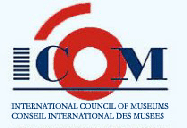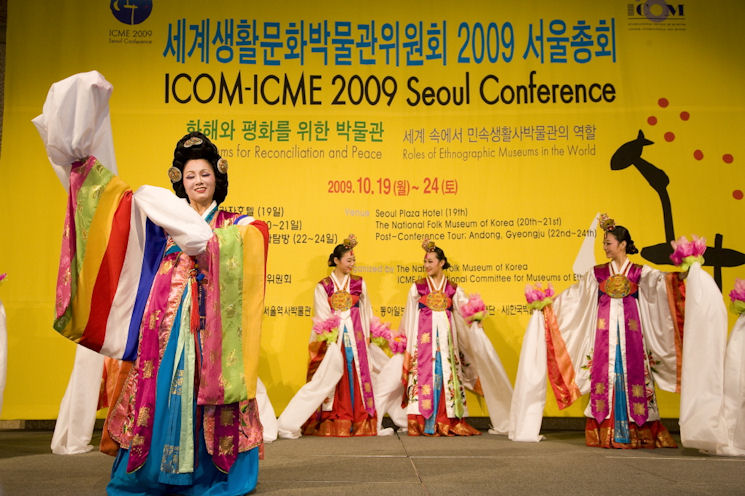 |
|
|||
|
REISERAPPORT
Museums for Reconciliation and Peace: comparing two minority-recruitment projects ICME 2009 Seoul Conference 19.10. - 24.10 |
 |
|
About the conference The Seoul Conference was organized by the National Folk Museum of South Korea in cooperation with the board of ICME, International Committee of Museums of Ethnography. Over 350 people participated in the conference – 282 Koreans and 73 non-Koreans, 30 countries were represented and nearly forty scientific papers were presented, including a number of invited keynote speakers. The papers were printed and made available to participants on a daily basis. For the last three days we were all invited to take part in a post conference tour to visit some of the most significant places of cultural heritage in South Korea; The city of Andong, and the Sekouguram grotto. The conference also adopted a charter of world culture and peace in Museums. The three first days of the conference consisted of formal speeches and presentations as well as cultural performances and formal dinners. The Koreans are expert organizers and have a wonderful ability to make their guests feel comfortable and appreciated. A large core of highly qualified helpers and interpreters made an impressing effort to make our visit as pleasant as possible. The food was also an incredible experience to get acquainted with. Two related projects As one of the presenters I will make a comparison between the project Martin Earring presented and the project I presented. The presentation of Martin Earring from National Museum of the American Indian, NMAI was titled: “Welcome to a Native Place – The Importance of Indigenous recruitment and Retention to The National Museum of the American Indian, Smithsonian Institution.” He gave the presentation regarding their concern and efforts to establish positions for indigenous people in the museums. I find it interesting to make a brief comparison between the recruitment project we perform in Norway: Mangfold i museene, Mim, and the way they go about this similar issue in the US. In a comparative perspective there are also interesting lessons to be learned for the indigenous, Sámi museums in Norway on how to enquire about peoples feelings regarding the employment programmes and how to make them even better. My presentation was titled: “Mim – A Way to do Diversity in Norway”. There are two distinct aims for this work: one is about inclusion in the museum sector, the other is to strengthen the diversity in society as a whole. The project aims at diversify the workforce in Norwegian museums by capturing the competence of individuals with a background from immigrant, refugee, national minority and indigenous groups in various museum professions. The project also aims to create openings for interested individuals to build their competence as professionals within the museums sector. We see this as one possible approach to combat social inequality, and in this way the museums involved are actively working towards a better and more inclusive society. By October 2009, 7 people have participated in project and 5 institutions. The programme is launched by the National Network: Diversity in the museums (Mangfoldsmuseene) “Welcome To A Native Place” Martin Earring has interviewed the people who are or have been participating in the programme, representing various groups. The programme has really managed to engage a wide range of people from more than 39 indigenous groups in North America. The programme gives the participants a choice between two roles they may choose to perform within the museum. These are; the Visitor Service and the Cultural Interpreter positions. Visitor Services Representatives are in charge of facilitating visitation to NMAI, welcoming every visor and helping them to find their way through the museum as well as providing the Native perspective to the visitors. The Cultural Interpreters provide tours for the visitors daily. The interpreters provide customized tours to all groups of visitors; school-children as well as visiting international diplomats. They receive professional training every year – whether it is part of continuing their own education or in the museums operations. Earring states that indigenous recruitment is essential to the NMAI “Museums visitors desire a better understanding of indigenous peoples and cultures and to make a human connection with the exhibits and items of material culture.” The human connection provides the first hand and best quality experience on how indigenous culture is alive and form dynamic parts of the complex US society.” Earring explains some of the difficulties in getting native peoples to move far away from their families and friends to work in Washington DC and these may be specific problems that develop because of the large distances. One way of coping with some of the personal problems that the participants in the programs experience was to engage a traditional healer to meet the participants and work with them several times each year. This was a very interesting approach and useful information to learn how the museum chooses new approaches to strengthen the indigenous recruitment programmes. Brief comparison of the two projects The Mim program in Norway is very different, encompassing people from various minority groups, indigenous as well as national minorities and representatives from new migrations. What is the essential lesson I do think is how the programme in “Welcome to A Native Place” emphasize to take care of the participants and they are encouraged to stay on. It is hard for us to imagine the large differences between the life on the reservation, in their home communities and life in Washington DC. As one cultural Interpreter put it: “It was really scary for me to pick up and move to a city I had been only once before. My whole family thought I was crazy. My grandparents still want to talk to me every morning to make sure that I’m okay. You know that nobody got me on the way home. That I`m out here in the crazy big city;” On the positive side, nine of the participants have moved on in their careers as direct results of participating in the programme. When comparing our experiences in Norway and the experiences in the Smithsonian – it is obvious that both the programmes have great potential to develop and be strengthened in various ways. In Norway one person is engaged in a 50% position to be the programme coordinator, if this position is changed to 100% the coordinator may be able to perform the very important job of travelling around and visit the recruits at various times, encouraging them, listening to their experiences and helping both the host institutions, the mentors and the recruits to get the most out of the programme. In NMAI the programme is organized as job-positions where the participants get paid normal wages, this will be a great advantage when we may go though with a similar system in Norway. To emphasize the value of the human connection and be aware of the important role the museum may play in giving opportunities for interested people to develop their skills and become role models is also an interesting area to develop further. The ICME 2009 Seoul conference provided inspiration on many levels of museums work, and maybe we will be able to arrange international seminars; sharing our experiences and exchange ideas in the field of recruiting people with special minority competence, in the future. |
||||
| ▲ til toppen Tilbake til reiserapporter 2009 |